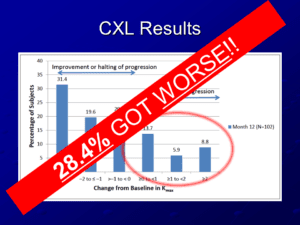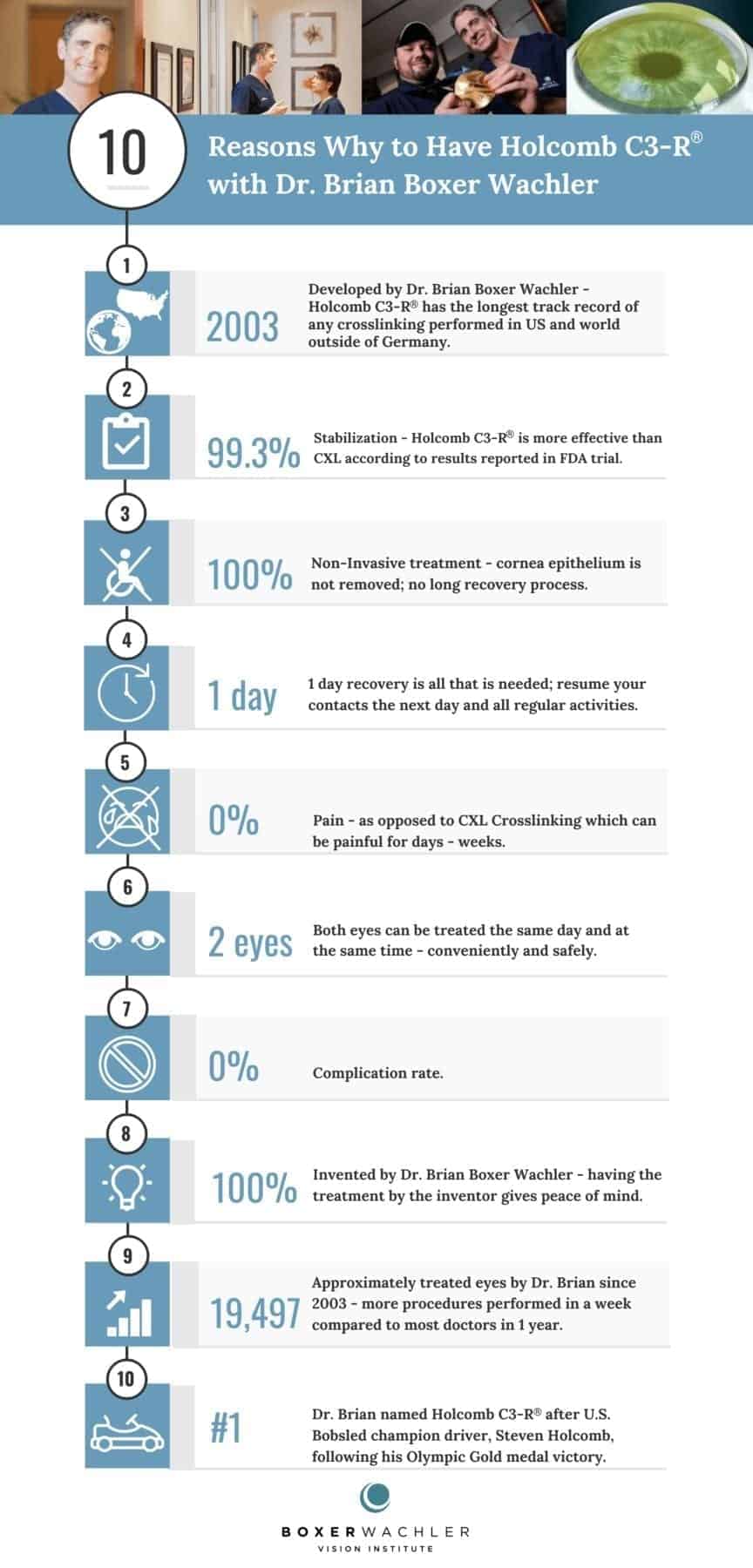Better Form of Corneal Cross Linking in Los Angeles
C3-R: Superior Cross Linking (CXL)
Holcomb C3-R has the longest track record of any form of crosslinking in North America, and the only proven non-invasive form of crosslinking with no complications or side-effects. Crosslinking without removing the epithelium is not painful and has caused others to not want to have both eyes treated, and instead just do our easy procedure.
Here are just a few facts of Holcomb C3-R® vs CXL (derived from published studies on crosslinking approved in US):

6 Reasons to Choose C3-R and Not Wait
- Progression rate for Holcomb C3-R is 0.7% since we have begun treatment in 2003.
- In comparison, progression rate of CXL patients is 28.4% in just 12 months of the CXL clinical trials. It has 40x’s higher rate of progression than Holcomb C3-R!
- This means CXL has a 2,000% higher rate of progression than Holcomb C3-R!
- 26.5% of CXL patients lost vision at one month post operatively
- Study focused more on epi-off, and did not publish data on rate of progression of epi-on. So if U.S surgeons are doing epi-on, this was not evaluated by the FDA. Therefore, the results are unknown, and certainly would not be better than epi-off CXL progression rate.
- Side effects of CXL: Ulcerative Keratitis, Corneal Haze, Punctate Keratitis, Epithelial Defect, Extreme Pain/Discomfort, Reduced Vision/Blurry Vision. Holcomb C3-R covers 157% more surface area than CXL and uses customizable energy levels (CXL’s are fixed)
Holcomb C3-R® Patients Compare Recovery to Standard Corneal Cross Linking
Complications of Standard, “Epi-Off” Corneal Cross Linking
The complication rate of “epi-off” (removal of epithelium) CXL crosslinking procedure was recently reported to be high at 11%. Complications of CXL include:
- Severe pain
- Corneal infection and ulceration
- Corneal haze
- Delayed epithelial healing
- Worse, more blurry vision
- Delay in corneal nerve regeneration
- Permanent corneal scarring
- Induced visual distortions
- Peripheral flap melting in patients who had previous LASIK and flap dislodgement
- Cornea swelling that never goes away
- Damage to iris causing change in eye color
- Extended light sensitivity
- Cornea perforation (hole was accidentally made through entire thickness of cornea)
The above CXL complications have NEVER occurred with the Holcomb C3-R® Crosslinking System.
C3-R Cross Linking Benefits
The retreatment rate with the Holcomb C3-R® Crosslinking System is 0.7% (less than 1%) which is significantly less than Epi-off CXL which have retreatment rates as high as 7%. Why the much lower retreatment rate with Holcomb C3-R®? There are two powerful reasons:
1) Dr. Brian customizes the energy level he uses for each patient, so he customizes the amount of crosslinking for your eyes. He is the only doctor who can do this. Other devices that doctors use only have a single low energy setting that they cannot change. As a result, a number of people who have CXL elsewhere unfortunately are “under-crosslinked” which is the reason the rate of Keratoconus progression is significantly higher with CXL than Holcomb C3-R®. Holcomb C3-R® gives you “peace-of-mind.”
2) Holcomb C3-R® Crosslinking System covers the greatest corneal area for crosslinking – it covers 157% more surface area of the cornea compared to other techniques such as CXL. This allows for a more complete area of treatment which is important since Keratoconus extends into the periphery of your cornea . We make sure we treat your central cornea areas as well as the far periphery of your corneas with the Holcomb C3-R® Crosslinking System.
This is the reason that 99.3% of people are stabilized with just a single treatment.
 CHART REVIEW AND CONSULTATION FOR OUT-OF-TOWN PATIENTS
CHART REVIEW AND CONSULTATION FOR OUT-OF-TOWN PATIENTS
Many out-of-town patients would like Dr. Brian to do a complimentary review of their medical records and make a preliminary determination of candidacy. This is useful before planning a trip to Beverly Hills.
Some people’s friends ask them, “Why are you thinking of travelling to Beverly Hills for your eye procedure?” They typically answer with, “I deserve the BEST and I want to go to the BEST doctor!”
These are the three easy steps for your complimentary chart review with Dr. Brian:
- Along with your last 2 or 3 eye exams, please be sure to include a color copy of your corneal mapping. Color corneal mapping is a very important tool, along with your exam history, to determine your candidacy. The last 2 years of your total eye history will be used to make this preliminary determination.
- Inside the envelope, please be sure to include a cover sheet with your name address, phone number and email address and the words, “Keratoconus Record Review”, so that we may optimize communication with you.
- Enclose with your letter a copy of your records.
Mail to:
Boxer Wachler Vision Institute
Keratoconus Record Review
465 N. Roxbury Drive, Suite 902
Beverly Hills, CA 90210
Or you can scan your records and email them to info@boxerwachler.com.



 CHART REVIEW AND CONSULTATION FOR OUT-OF-TOWN PATIENTS
CHART REVIEW AND CONSULTATION FOR OUT-OF-TOWN PATIENTS